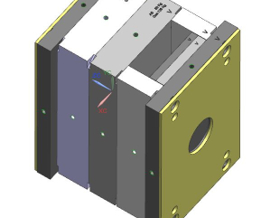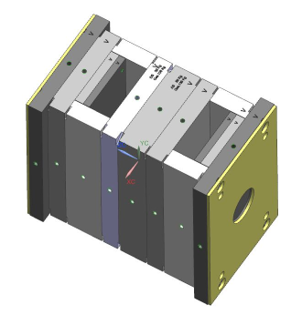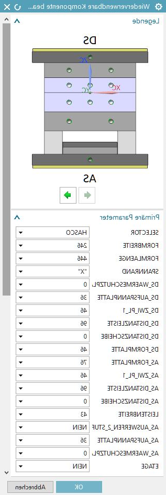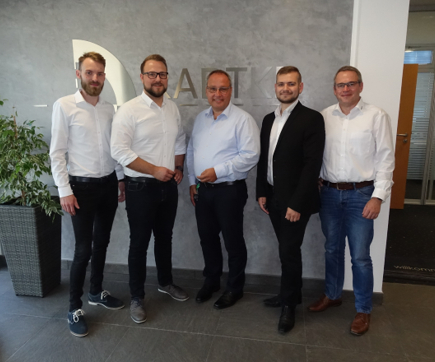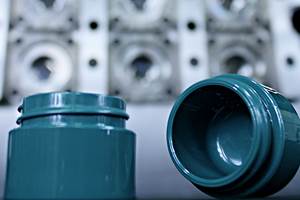Parametric Data Provides Faster Injection Mold Design
To be able to design molds in as effective and time-saving manner as possible, HASCO America Inc. and Radtke design office teamed up for the provision of native, parameterized data.
The key advantage of native data, compared with STEP files or other exchange formats, is that it can be easily modified, which also makes it much easier to handle the data of required components in parts lists. Hasco was prompted to offer this data to optimize the design of injection molds through the close cooperation with the Radtke design office in Espelkamp/Germany. Over the past few years, Radtke has been working intensively on the use of native data and has shown how users can benefit from the options and advantages it opens up.
After founding his own business on the side in 1993 and switching to full self-employment in 1997, Horst Radtke, founder and owner of the Radtke design office, made the move into 3D-CAD design. Today, the company employs four designers and one technical drawer for the design of injection molds. Since 2016, the company has been consistently pursuing the rejuvenation process required for the future.
A further key focus of the work carried out at the design office is on complex plug molds, especially for the automotive industry and white goods. Nested molds with up to 64 cavities are designed here. They are capable of processing TPE and LSR silicones, as well as PA66GF30, PC, PBT and other engineering plastics. In addition, Radtke and his team also design molds for medical technology and other sectors, including the consumer goods and packaging industries.
To be able to design molds of this type in as effective and time-saving manner as possible, the desire arose for the provision of native, parameterized data rather than the STEP data supplied by the standard-component manufacturers.
Parametric Data for faster Mold Design
“When I download design data from the standard-component manufacturers from the internet, I have so far generally been working with STEP data,” Radtke explains. But STEP data is dead data, compared with a screenshot.
Against this background, the Radtke design office began to develop its own database of parametrized data for standard components. In the initial stage, Hasco provided Excel lists with the necessary parameters.
The actual design is only one part of the entire process. Parts lists and order lists also have to be generated. This metadata runs in the background and is also now automatically updated – something that is not possible when using STEP data. As a rule, this data is loaded directly into the customer’s CAD system via an exchange format. During the transfer, however, parameters and information for individual products can get lost.
The creation of a parametric component database was only the first step, because the parametric data can naturally be used intelligently in a large number of other ways.
Radtke has also designed a large number of component assemblies and saved them in parametric form, including a “starting assembly” with a variable configuration of ejector systems, plate numbers and tandem and stack technologies. Everything is parametric, with the corresponding metadata for compiling the parts list, which is updated in the background. Only the material grades and hardnesses have to be entered manually. One key aim of the whole process is that parts lists should require as little manual editing as possible. All the other data is provided by the CAD system and read out into customer-specific templates and exported. Therefore, compilation of the mold base and the associated parts list requires considerably less effort.
Hasco ultimately came up with the idea of meeting all its customers’ wishes by supporting them with native data. Andreas Kaersch, technical sales engineer in the Hasco Team West, recommends a close and intensive dialogue between designers, standard-component suppliers and moldmakers. The main aim of the joint project was to offer a solution which would facilitate the work of as many users as possible. All customers wanting support now receive an extensive package that considerably facilitates and speeds up their work.
Related Content
Take Time to Save Time: 6 Steps in Mold Design to Reduce Back-End Troubleshooting
Westminster Tool shares how the one week it typically takes to perform these six steps in the design phase can save three weeks or more in an overall tool build.
Read MoreWhat Is Scientific Maintenance? Part 1
Part one of this three-part series explains how to create a scientific maintenance plan based on a toolroom’s current data collection and usage.
Read MoreHow to Use Scientific Maintenance for More Accurate Mold and Part Troubleshooting
Discover how adopting scientific maintenance approaches helps improve mold lifespan, minimize failures, and optimize production outcomes.
Read MoreHow to Analyze and Optimize Cutting Conditions to Reduce Cycle Time
Plastic injection mold design and manufacturing company puts NC program optimization software module to the test. The results were surprising.
Read MoreRead Next
How to Use Continuing Education to Remain Competitive in Moldmaking
Continued training helps moldmakers make tooling decisions and properly use the latest cutting tool to efficiently machine high-quality molds.
Read MoreReasons to Use Fiber Lasers for Mold Cleaning
Fiber lasers offer a simplicity, speed, control and portability, minimizing mold cleaning risks.
Read MoreHow to Use Strategic Planning Tools, Data to Manage the Human Side of Business
Q&A with Marion Wells, MMT EAB member and founder of Human Asset Management.
Read More






